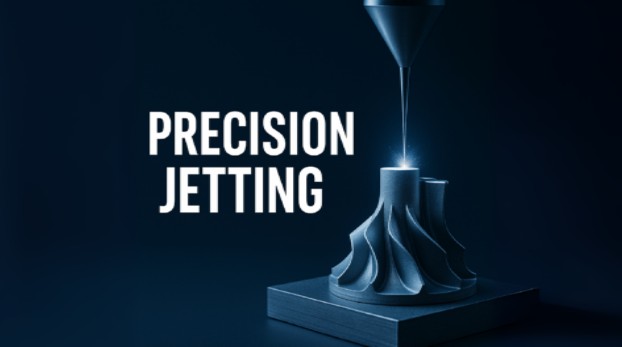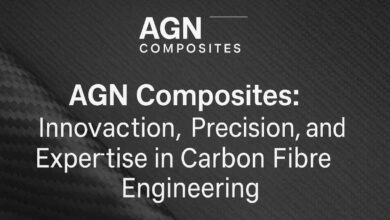How Precision Jetting Is Revolutionizing Aerospace Manufacturing

Precision jetting is revolutionizing aerospace manufacturing by enabling the creation of aerospace components, from turbine blades to spacecraft, with unprecedented accuracy. This cutting-edge additive manufacturing technology builds components layer by layer, leading to lighter aircraft, more efficient engines, and reduced material waste.
What is Precision Jetting?
Precision jetting represents a sophisticated additive manufacturing technology that uses precisely controlled streams of material to build components with extraordinary accuracy. The process involves depositing tiny droplets of material—whether metal, ceramic, or polymer—exactly where they’re needed to create three-dimensional parts.
The technology operates on principles similar to inkjet printing but at a microscopic scale with materials far more complex than ink. Advanced water jet nozzles control the flow and placement of materials with tolerances measured in micrometers. Computer-controlled systems guide these jets to deposit material according to precise digital blueprints, allowing manufacturers to create parts with internal geometries and features that would be impossible using conventional machining.
What sets precision jetting apart from traditional subtractive manufacturing is its additive approach. Instead of starting with a large block of material and removing unwanted portions, precision jetting builds parts from the ground up. This fundamental difference opens up new possibilities for part design and dramatically reduces material waste.
The process can work with various materials simultaneously, enabling the creation of multi-material components with different properties in different regions. For aerospace applications, this means engineers can optimize parts for strength in some areas while maintaining lightweight properties in others.
Applications in Aerospace
The aerospace sector has embraced precision jetting for numerous critical applications that showcase the technology’s versatility and precision capabilities.
Complex Engine Components
Modern jet engines contain intricate parts with internal cooling channels and complex geometries that challenge traditional manufacturing methods. Precision jetting excels at creating turbine blades with internal cooling passages that follow optimal heat transfer paths. These channels can twist, branch, and vary in diameter throughout the blade, something virtually impossible to achieve through conventional drilling or casting.
Lightweighting Initiatives
Aircraft manufacturers constantly seek ways to reduce weight without compromising structural integrity. Precision jetting enables the creation of lattice structures and hollow components that maintain strength while significantly reducing mass. These weight savings translate directly into improved fuel efficiency and increased payload capacity.
Heat Exchangers and Thermal Management
Spacecraft and aircraft require sophisticated thermal management systems to handle extreme temperature variations. Precision jetting can create heat exchangers with optimized surface areas and flow paths that maximize heat transfer efficiency while minimizing size and weight.
Rapid Prototyping and Custom Parts
The aerospace industry often requires custom components in small quantities, making traditional manufacturing methods cost-prohibitive. Precision jetting allows engineers to rapidly prototype new designs and produce limited runs of specialized parts without expensive tooling.
Advantages Over Traditional Methods
Precision jetting offers compelling advantages that are driving its adoption across the aerospace industry.
Material Efficiency
Traditional machining can waste up to 90% of raw materials, particularly when creating complex parts from expensive aerospace alloys. Precision jetting uses only the material needed for the final part, dramatically reducing waste and associated costs. This efficiency becomes particularly valuable when working with exotic materials like titanium or superalloys.
Design Freedom
The additive nature of precision jetting eliminates many design constraints imposed by conventional manufacturing. Engineers can create parts with overhangs, undercuts, and internal features that would require multiple components or complex assembly procedures using traditional methods. This design freedom often leads to more efficient, integrated solutions.
Reduced Lead Times
Precision jetting eliminates the need for custom tooling, fixtures, and multiple machining operations. Parts can go directly from digital design to finished component, significantly reducing production lead times. This speed advantage is particularly valuable for prototype development and low-volume production runs.
Quality and Consistency
The computer-controlled nature of precision jetting ensures consistent quality across multiple parts. Each component is built according to the exact digital specifications, reducing variability and improving reliability. This consistency is crucial for aerospace applications where part-to-part variation can affect performance and safety.
The Future of Aerospace Manufacturing
Precision jetting is positioned to play an increasingly important role in aerospace manufacturing as the technology continues to mature and expand its capabilities.
Integration with Digital Manufacturing
The future of aerospace manufacturing lies in fully integrated digital workflows where parts are designed, optimized, and manufactured within connected systems. Precision jetting fits seamlessly into this vision, as it relies entirely on digital data to guide the manufacturing process. This integration enables real-time optimization and quality control throughout production.
Advanced Materials Development
Ongoing research is expanding the range of materials compatible with precision jetting. New aerospace-grade alloys, composites, and smart materials are being developed specifically for additive manufacturing processes. These materials will enable the creation of parts with properties tailored for specific applications.
Scaling for Production
While precision jetting has proven effective for prototypes and small-batch production, efforts are underway to scale the technology for higher volumes. Multi-nozzle systems and automated post-processing equipment are making it possible to produce larger quantities while maintaining the precision and quality advantages.
Sustainability Focus
Environmental considerations are becoming increasingly important in aerospace manufacturing. Precision jetting’s material efficiency and ability to create lighter components align perfectly with sustainability goals. The technology reduces both manufacturing waste and operational fuel consumption.
Challenges and Solutions
Despite its advantages, precision jetting faces several challenges that the industry is actively addressing.
Material Certification
Aerospace components must meet stringent certification requirements, and parts produced through precision jetting must undergo extensive testing and qualification processes. Industry organizations are developing standards and testing protocols specifically for additively manufactured aerospace components.
Surface Finish and Post-Processing
Parts produced through precision jetting may require additional finishing operations to meet surface quality requirements. Advanced post-processing techniques, including chemical smoothing and precision machining, are being developed to achieve the required surface finishes efficiently.
Production Speed
While precision jetting offers advantages in setup time and design flexibility, the actual build process can be slower than traditional manufacturing for certain parts. Ongoing technology improvements focus on increasing deposition rates while maintaining precision.
Cost Considerations
The initial investment in precision jetting equipment can be substantial, and material costs may be higher than traditional manufacturing feedstock. However, the total cost equation often favors precision jetting when considering material waste reduction, tooling elimination, and inventory benefits.
Conclusion
Now that you have a better understanding of precision jetting technology, its applications, and advantages, it’s clear that this additive manufacturing method has a lot to offer in terms of efficiency, flexibility, and cost-effectiveness.



